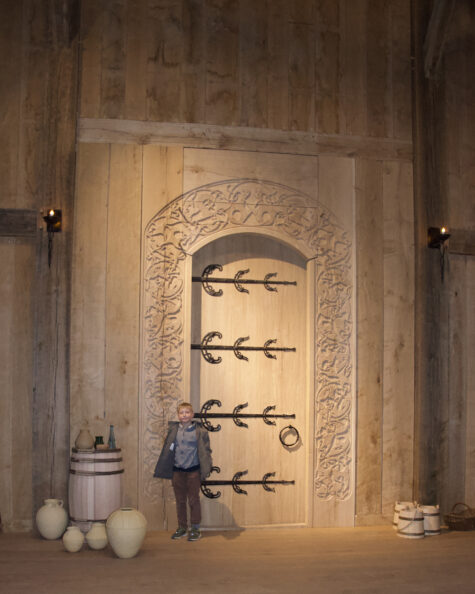The heroic poem about Beowulf is often considered the most accomplished example of Old English poetic literature. Based on an oral transmission of a Scandinavian epic from the 6th century, however, it presents a convoluted history

The poetic text of Beowulf is preserved in a single manuscript dated to ca. AD 1000 known as the Beowulf Manuscript (Cotton MS Vitellius A XV). Nearly destroyed in a fire, the manuscript is a fragment. In the late 20th century, Canadian scholars at the University of Toronto questioned an early date for the poem. However, careful linguistic studies of the text have afterwards successfully argued that the poem was written down ca. AD 700. A recent archaeological study of the poem argues that this written transmission was based on an oral version brought to England in the early 7th century together with the “Swedish” objects in the grave at Sutton Hoo ca. AD 625. It has been speculated that the poem accompanied the famous helmet found in the grave, which may have held the remains of Raedwald. From Bede, we know this warrior king married a foreign princess; perhaps she was Swedish? Based on a painstaking and thorough examination of the material culture and the historical persons mentioned in the poem, the oral composition is likely to be dated to AD 530-60.
There is no evidence of a historical Beowulf, but some characters, sites, and events in the poem can be historically verified.
Beowulf falls into two parts. It opens in Denmark, where King Hrothgar has built an impressive mead hall known as Heorot, a place for convivial and merry entertainment. Boisterous noise, however, infuriates the monster, Grendel, who lives in a nearby swamp. Each night Grendel visits and carries off warriors to devour them in his watery hole. Enter the hero, Beowulf, a prince of the Geats, a tribe from Gotland. With a small band of men, he takes it upon himself to rid Hrothgar of Grendel, described as a water-wulf. After much feasting, Grendel rises from the swamp and enters the hall while devouring one of Beowulf’s Geats. Following this, the two combatants engage in a mortal fistfight, which ends with Beowulf tearing off the monster’s arm leading to its death. Beowulf then exhibits the monster’s arm hanging it from a beam for all to see.
The next day sees more feasting ending with a replay as Grendel’s mother in the night arrives to avenge the death of her son by killing another of the men gathered in the hall. In the morning, this provokes Beowulf to dive into the swamp to best her. There, he kills her with his sword. In the cave, the hero discovers the dead body of Grendel, cuts off his head and returns to Hrothgar with these spoils. Before returning to his uncle, King Hygelac of the Geats, Beowulf is amply rewarded with an honourable speech and magnificent gifts, among which is the famous necklace of .
In the second part, we meet Beowulf again after he has inherited the kingship from Hygelac and his son. Rewarded with fifty years of peaceful rule, Beowulf is finally once more confronted with a fire-breathing dragon. Although old, feeble, and deserted by his men, Beowulf engages in his final fight by killing the monster, however, at the cost of a mortal wound. The poem ends with the famous description of how Beowulf is laid to rest on a ship burned as part of his cremation. Finally, the hero’s remains are buried in a barrow near the sea.
The epic belongs to the Germanic heroic tradition in terms of style, meter, and theme. However, the composition may also be reminiscent of a Christianised slant. Thus, Beowulf is more altruistic than the garden variety of the fatalistic Scandinavian hero engaged in blood feuds. Also, the poem has been characterised as a lyrical elegy more than an epic. Perhaps it was composed as a 6th-century dirge, a sombre song or lament expressing mourning or grief, such as would be appropriate for performance at a funeral.
The Danish-Icelandic antiquarian Grímur Jónsson Thorkelin carried out the first edition of the poem of Beowulf in 1815. Thorkelin published the poem with the title: De Danorum Rebus Gestis …Poëma Danicum Dialecto Anglosaxonica and based on transcription he made in London in 1789-91, thus preserving some 1900 letters later lost from the fragile manuscript. Then, in 1817 N.F.S. Grundtvig published his translation into Danish. Since then, the poem has been translated into numerous languages and turned into films, TV and operas. In addition, various video games and comic books were inspired by Beowulf.
SOURCES:
The manuscript holding the poem of Beowulf belongs to the British Library. Beowulf has been made available for scholars and historians in two forms – a full digitises version and an electronic edition, The Electronic Beowulf, a collaboration between the British Library and the University of Kentucky.
A famous translation was carried out by the Irish poet Seamus Heyney in 2000. Another translation was done by Tolkien in 1926 and published posthumously in 2014 by his son, Christopher Tolkien. A third edition is a valuable addition presenting the text and a translation vis-à-vis. Finally, a new book recently presented a “community translation”, inviting readers to try their own hand.














